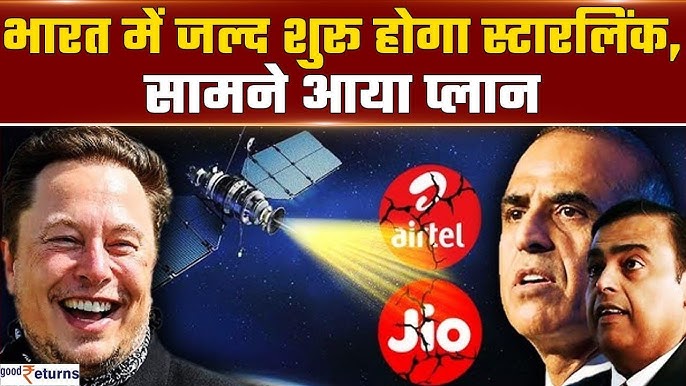
Why India Needs Elon Musk's Starlink to Break the Airtel and Jio Duopoly
In India, the telecom industry is dominated by two major players: Reliance Jio and Bharti Airtel. These companies control most of the broadband and mobile services market, leaving limited room for competition. The introduction of Elon Musk’s Starlink, a satellite internet service, could potentially disrupt this duopoly and bring much-needed changes to India’s internet landscape. Here’s why Starlink could be a game-changer in breaking the stronghold of Airtel and Jio.
The Current Internet Scenario in India
India’s internet user base is massive, with over 850 million active users, but broadband penetration, especially in rural areas, remains a challenge. Reliance Jio and Airtel dominate the market, holding more than 80% of the share collectively. Despite their reach, connectivity in remote regions is still inadequate due to the limitations of traditional telecom infrastructure.
Most broadband services rely on fiber optic or cellular networks, which are costly and time-consuming to install across the country. This results in slow internet speeds and frequent outages in less developed areas. The Airtel-Jio duopoly has been criticized for focusing on urban markets and neglecting remote regions, leading to a digital divide.
How Starlink Works
Starlink is a satellite internet constellation operated by SpaceX, consisting of thousands of low-earth orbit (LEO) satellites. Unlike traditional broadband services that depend on ground infrastructure, Starlink’s satellite-based system can deliver high-speed internet directly to any location on Earth. This approach makes it ideal for reaching rural and underserved areas where traditional telecom companies struggle to provide reliable service.
Starlink’s Potential to Disrupt the Market
- Bridging the Rural Connectivity GapOne of the most significant advantages of Starlink is its ability to offer high-speed internet in areas where terrestrial networks fall short. In India, about 60% of the population resides in rural areas where the digital divide is still pronounced. While Jio and Airtel have made some efforts to expand coverage, their reach in remote regions remains limited due to high costs associated with laying cables and building infrastructure.Starlink can bypass these limitations by providing satellite-based connectivity directly to users. This would be a major step toward achieving digital inclusion and empowering rural communities with better access to education, healthcare, and economic opportunities.
- Breaking the Pricing MonopolyThe existing duopoly enables Jio and Airtel to maintain pricing control, as there are few alternatives for consumers. The entry of Starlink could introduce more competition in the broadband market, leading to better pricing and service quality for users. Starlink’s flexible subscription plans and global pricing standards could push traditional telecom operators to improve their offerings.
- Innovating the Internet EcosystemThe arrival of Starlink could foster innovation in India’s internet ecosystem by encouraging competition not just among broadband providers but also across related sectors like content streaming, online gaming, and digital services. When new entrants disrupt established markets, they often bring new technologies, business models, and service improvements that can benefit consumers.
The Debate Over Spectrum Allocation
A significant hurdle for Starlink’s entry into India has been the debate around spectrum allocation. Indian telecom giants, particularly Reliance Jio, have pushed for a spectrum auction for satellite internet services. This stance contrasts with Starlink’s preference for administrative allocation, which aligns with international practices. The concern is that an auction could significantly increase costs for satellite service providers, potentially hindering the expansion of services like Starlink.
Recently, the Indian government decided to follow the global norm of administratively allocating satellite spectrum. This decision was a win for Starlink and other satellite-based internet service providers. It avoids the potentially prohibitive costs associated with spectrum auctions, making it easier for companies to launch affordable internet services across the country.
Challenges Facing Starlink’s Launch in India
- Regulatory HurdlesWhile the decision to allocate spectrum administratively is a positive step, Starlink still faces significant regulatory challenges. For instance, the company needs approval for satellite ground stations, user terminal licenses, and compliance with India’s data localization laws. Moreover, the established telecom players have substantial influence over regulatory bodies and may lobby against policies favoring satellite internet providers.
- Cost Barriers for ConsumersStarlink’s equipment costs, including the satellite dish and receiver, are higher than traditional broadband installations. For many users in rural India, the initial investment could be a barrier. To succeed, Starlink might need to offer subsidized pricing or work with the government on schemes to make the service more affordable.
- Market Penetration IssuesThe existing dominance of Jio and Airtel means that even if Starlink enters the market, it will need to work hard to convince customers to switch. Loyalty programs, data bundling, and existing customer relationships could give Jio and Airtel an advantage in retaining subscribers. Additionally, Starlink’s reliability during adverse weather conditions remains a concern, as satellite signals can be affected by heavy rain or storms.
Why India Needs Starlink Now More Than Ever
- Digital India InitiativesThe Indian government’s push for digital transformation, through programs like Digital India, requires widespread internet access. To make initiatives like online education, digital payments, and e-governance successful, robust internet connectivity is essential. Starlink’s ability to offer reliable services in remote locations aligns well with these objectives, making it a strategic partner for India’s digital ambitions.
- Support for Remote Work and EducationThe COVID-19 pandemic has demonstrated the importance of internet connectivity for remote work and online education. As the economy increasingly moves towards digital solutions, ensuring that all citizens have access to fast and reliable internet becomes crucial. Starlink can play a pivotal role in expanding internet access to underserved areas, making remote work and education more feasible.
- Supporting the Startup EcosystemA competitive broadband market driven by Starlink could lower internet costs and improve service quality. This would benefit the startup ecosystem by making cloud-based tools, digital services, and online platforms more accessible. Improved connectivity could lead to the rise of new digital businesses in previously underconnected regions, contributing to India’s economic growth.
Conclusion
The entry of Elon Musk’s Starlink into India could disrupt the existing duopoly of Airtel and Jio, fostering competition and bringing significant improvements to internet accessibility. By leveraging satellite technology, Starlink has the potential to bridge the digital divide, support government initiatives, and drive economic growth. While challenges remain, including regulatory hurdles and cost concerns, the benefits of breaking the Airtel-Jio duopoly make a compelling case for Starlink’s expansion into India.








You just don’t understand telecom in India so don’t make sensational baseness statements and try to get more eyeballs…